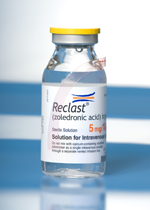Product
Reclast
Approval Date
April 16, 2007
Release Date
May 25, 2007
Company
Novartis
Class
Bisphosphonate
Indication
Treatment of Paget’s disease of bone in men and women.
Active Ingredient
Zoledronic acid 5mg/100mL bottle; soln for IV infusion.
Agency Roster
McCann HumanCare(consumer)
Regan CampbellWard-McCann (professional)
MRM Worldwide(relationship marketing, experiential marketing)
MomentumWorldwide (experiential marketing)
MarketingStrategy/Execution
Shortly aftersecuring approval for Paget’s disease of the bone, Novartis won rights tomarket Reclast for postmenopausal osteoporosis. The label expansion boosted thedrug’s commercial potential considerably. While Paget’s disease is estimated toaffect about one million people in the US, osteoporosis affects eight million,and IMS estimates the US osteoporosis market at $4.3 billion (see below), halfof which is comprised of oral bisphosphonates. Analysts estimated global salesof $100 million in 2007, reaching $550 million in five years with peak annual USsales of $300 million.
The Market
| Biophosphanate US sales ($000s) last 5 years | |
| 2006 |
$4,335,418 |
| 2005 |
$4,013,767 |
| 2004 |
$3,680,742 |
| 2003 |
$3,164,462 |
| 2002 |
$2,576,628 |
| Source: IMS Health, Oct. 2007 |
|
| Top 5 biophosphanate | ||
| Jan.-July ’07 US sales ($000s) | % sales growth over Jan.-July ‘06 | |
|
FOSAMAX (Merck) |
1,098,644 |
-6 |
|
ACTONEL (Procter & Gamble) |
611,446 |
-1 |
|
ZOMETA (Novartis) |
398,728 |
-7 |
|
BONIVA (Roche) |
288,445 |
82 |
|
FOSAMAX PLUS D (Merck) |
197,170 |
118 |
| Source: IMS Health, Oct. 2007 |
||
Physician Outlook
Novartis’ Reclast (zoledronic acid) is an intravenouslyadministered bisphosphonate that was recently approved for the management ofPaget’s disease of the bone. Zometa is given in a single, short infusion (withfurther treatments given at 18-month intervals). In contrast, the recommendedcourse of the oral bisphosphonates Fosamax (alendronate) and Actonel(risedronate) require a two- or six-month course of daily medication. Clinicalstudies suggest that Reclast has a faster onset of action and offers longerperiods of remission than currently available oral therapies. Reclast was alsorecently approved by the FDA for the management of post-menopausal osteoporosisas a yearly treatment.
—Michael Galvin, senior VP, GfK V2, Oct. 2007
Also in the Pipeline(according to Adis R&D Insight)
No competitor compounds in phase III or pre-registration, US
Recent MM&MCoverage
People news
TheTop 60: Regan Campbell Ward • McCann
Amgen’s’Dmab’ in need of differentiation: analyst
Newapproval for drug gives Novartis excuse to up promotion
Productnews from the 04/17/07 news brief
Studyshows Galvus less effective than generic: Novartis
Headliner:Nancy Lurker of Novartis
Pharmacology
Paget’s disease of bone is a chronic, focal skeletal disorder characterizedby greatly increased and disorderly bone remodeling. Excessive osteoclasticbone resorption is followed by irregular osteoblastic new bone formation,leading to the replacement of normal bone with disorganized, enlarged, andweakened bone structure.
Zoledronic acid is a bisphosphonate that works primarily on bone byinhibiting osteoclast-mediated bone resorption. It rapidly partitions to boneand localizes preferentially at sites of high bone turnover. The relativelylong duration of action is attributable to its strong binding affinity to bonemineral.
Treatment with Reclast is indicated in patients with Paget’s diseaseof bone with elevations in serum alkaline phosphatase (SAP) of two times orhigher than the upper limit of the age-specific normal reference range, orthose who are symptomatic, or those at risk for complications from theirdisease, to induce remission (normalization of SAP).
After a single treatment with Reclast in Paget’s disease an extendedremission period is observed. Retreatment with Reclast may be considered in patientswho have relapsed, based on increases in serum alkaline phosphatase, or inthose who failed to achieve normalization of their serum alkaline phosphatase,or in those with symptoms, as dictated by medical practice. Patients beingtreated with Zometa (also from Novartis) should not be treated with Reclastbecause they contain the same active ingredient.
Clinical Trials
The efficacy of one infusion of Reclast 5mg versus oral daily doses ofrisedronate 30mg for 2 months was evaluated in two identical 6-month,randomized, double-blind trials. Therapeutic response was defined as eithernormalization of SAP or a reduction of =75% from baseline in total SAP excessat the end of 6 months. In both trials Reclast demonstrated a superior and morerapid therapeutic response compared with risedronate and returned more patientsto normal levels of bone turnover as shown by biochemical markers of formationand resorption.
The 6-month combined data from both trials showed that 96% ofReclast-treated patients achieved therapeutic response compared to 74% ofpatients treated with risedronate. Also at the 6-month point, 89% of the Reclast-treatedpatients achieved normalization of SAP levels, compared to 58% ofrisedronate-treated patients. Most Reclast patients achieved a therapeuticresponse by the Day 63 visit.
In patients previously treated with oral bisphosphonates,therapeutic response rates were 96% and 55% for Reclast and risedronate,respectively. The comparatively low risedronate response was due to the lowresponse rate (7/23, 30%) in those previously treated with risedronate.
Adverse Reactions
Hypocalcemia, headache, dizziness, flu-like syndrome,fatigue, pyrexia, rigors, peripheral edema, asthenia, bone pain, myalgia, GIupset; possible osteonecrosis of the jaw.
Adults
Give by IV infusion over at least 15 minutes. CrCl=35mL/min: 5mg. Supplement with calcium 1500mg daily in divided doses and Vit.D 800 IU daily.
Children
Not recommended.
Contraindications
Uncorrected hypocalcemia. Pregnancy (Cat.D). Nursingmothers.
Precautions
Severe renal impairment: not recommended. Ensure adequatehydration, Vit.D and calcium intake.
Interactions
Additive hypocalcemic effect with aminoglycosides, loopdiuretics. Caution with other nephrotoxic drugs.









